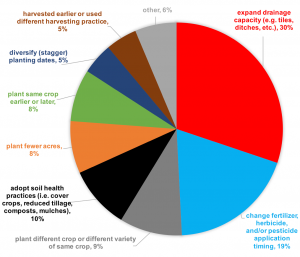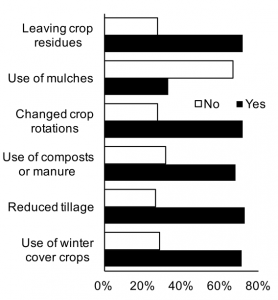Remarkable, how much things can shift in a single year. Case in point: the growing season in 2017 compared to that in 2016. The contrast was stark, with ’17 as wet as ’16 was dry.
These things matter to all of us. After all, there are over 35,000 farms in New York, covering over 20 percent of the state’s land. New York ranks in the top six nationally in the production of more than 22 agricultural commodities. Our ag economy contributes a lot to New York’s economic well-being. Milk alone is worth nearly $2.5 million.
True, it wasn’t wet everywhere in New York. But the places that were? Like they say: when it rains, it pours. Results?
- Saturated soil.
- Flooded fields.
- Delayed planting (or no opportunity to plant).
- Unable to get equipment into the field.
- Crop disease (wet soils promote disease).
More than half of farmers ranked these as extremely or very important. All were all directly linked to yield loss. But here’s something: 95 percent noted a negative effect on the quality of their crop.

Farmers in the wettest areas were the ones who responded to a recent Cornell survey seeking to learn the impact these heavy rains had on farmers and what they’d have done differently—had they but known. It’s title: The Anatomy of a Wet Year: Insights from New York Farmers.
For instance, 82 percent of farmers use drain tile or ditches to help cope with relentless rain. Seventy-two percent said the rains showed weakness or limitations in drainage infrastructure.

If you know the IPM mantra, you know that prevention is key to good IPM. But how do you stop the rain? The take-away: our farmers are likely to face new and potent climate-related problems, whether it’s increasingly heavy rains or short-term droughts. Researchers, extension educators, NYS IPM, NGO’s, planners, engineers, NYS Department of Agriculture and Markets—anyone with ties to agriculture in New York will be called on to help farmers adapt to an uncertain future.
_________________
References:
Northeast Regional Climate Center (NRCC) www.nrcc.cornell.edu/regional/monthly/monthly.html.
National Climate Assessment (NCA; 2014) nca2014.globalchange.gov/report/our-changing-climate/heavy-downpours-increasing#graphic-16693.
Sweet et al. (2017). www.sciencedirect.com/science/article/pii/S0168192317302800
Wuebbles et al. (2014). journals.ametsoc.org/doi/pdf/10.1175/BAMS-D-12-00172.1
“Anatomy of a Wet Year” was funded by Cornell University’s Atkinson Center for a Sustainable Future and The Nature Conservancy. For more information, contact Shannan Sweet: 607 255 8641, sks289@cornell.edu